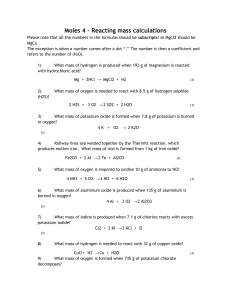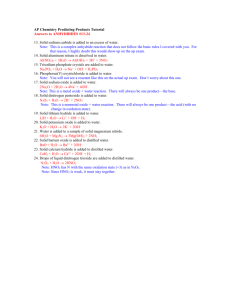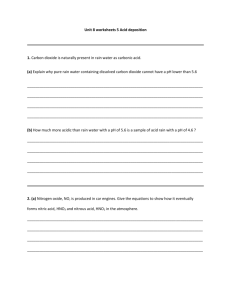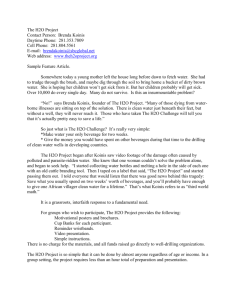Complete the following equations:
advertisement
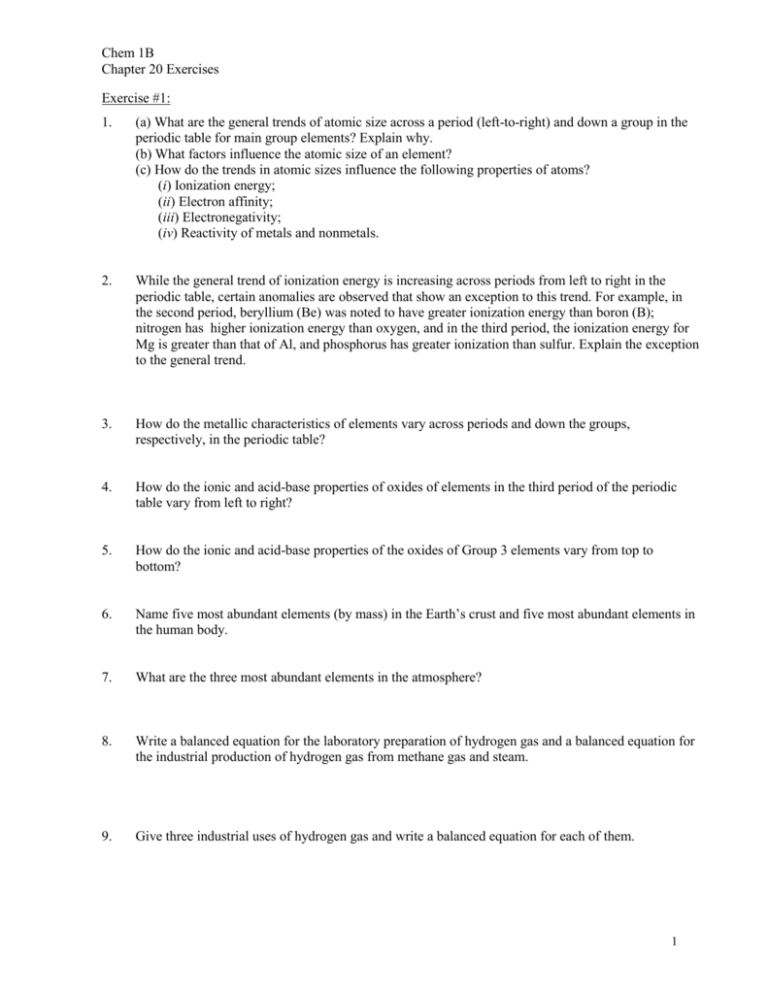
Chem 1B Chapter 20 Exercises Exercise #1: 1. (a) What are the general trends of atomic size across a period (left-to-right) and down a group in the periodic table for main group elements? Explain why. (b) What factors influence the atomic size of an element? (c) How do the trends in atomic sizes influence the following properties of atoms? (i) Ionization energy; (ii) Electron affinity; (iii) Electronegativity; (iv) Reactivity of metals and nonmetals. 2. While the general trend of ionization energy is increasing across periods from left to right in the periodic table, certain anomalies are observed that show an exception to this trend. For example, in the second period, beryllium (Be) was noted to have greater ionization energy than boron (B); nitrogen has higher ionization energy than oxygen, and in the third period, the ionization energy for Mg is greater than that of Al, and phosphorus has greater ionization than sulfur. Explain the exception to the general trend. 3. How do the metallic characteristics of elements vary across periods and down the groups, respectively, in the periodic table? 4. How do the ionic and acid-base properties of oxides of elements in the third period of the periodic table vary from left to right? 5. How do the ionic and acid-base properties of the oxides of Group 3 elements vary from top to bottom? 6. Name five most abundant elements (by mass) in the Earth’s crust and five most abundant elements in the human body. 7. What are the three most abundant elements in the atmosphere? 8. Write a balanced equation for the laboratory preparation of hydrogen gas and a balanced equation for the industrial production of hydrogen gas from methane gas and steam. 9. Give three industrial uses of hydrogen gas and write a balanced equation for each of them. 1 Chem 1B Chapter 20 Exercises Exercise #2: 1. Rank the alkaline metals in order of increasing ionization energy and increasing reactivity. 2. Name three common and important compounds of sodium; write their formulas and their uses. 3. Write the major product in each of the following reactions between lithium, sodium and potassium metals with oxygen gas. (a) Li(s) + O2(g) ? (b) Na(s) + O2(g) ? (c) K(s) + O2(g) ? 4. Briefly explain the production of sodium metal from NaCl. ___________________________________________________________________________________ The Production of Magnesium from Seawater. (Concentration of Mg2+ in seawater is about 0.055 M) 1. Mg2+(aq) + Ca(OH)2(aq) Mg(OH)2(s) + Ca2+(aq) 2. Mg(OH)2(s) MgO(s) + H2O(g) 3. MgO(s) + 2HCl(aq) MgCl2(aq) + H2O(l) 4. MgCl2(aq) (goes into a dryer) MgCl2(s) (melted) MgCl2(l) (electrolysis) Mg(l) + Cl2(g) The Production of Magnesium from MgCO3 (Dolomite): 1. MgCO3(s) MgO(s) + CO2(g) 2. MgO(s) + 2HCl(aq) MgCl2(aq) + H2O(l) 3. MgCl2(aq) (goes into a dryer) MgCl2(s) (melted) MgCl2(l) (electrolysis) Mg(l) + Cl2(g) The Production of Calcium from CaCO3: 1. CaCO3(s) CaO(s) + CO2(g) 2. CaO(s) + 2HCl(aq) CaCl2(aq) + H2O(l) 3. CaCl2(aq) (goes into a dryer) CaCl2(s) (melted) CaCl2(l) (electrolysis) Ca(l) + Cl2(g) 2 Chem 1B Chapter 20 Exercises Exercise #3 1. Rank the alkaline Earth metals in order of increasing reactivity. 2. In what ways is beryllium different from other Group 2A elements? What factor (or factors) makes beryllium different from the other metallic elements? 3. Briefly describe the Dow’s process for the production of magnesium from seawater. Provide a balanced equation for each step involved. 4. The concentration of Mg2+ in seawater is about 0.055 M. (a) How many liters of seawater will produce 1.00 kg of magnesium. (b) How many kilograms of calcium oxide, CaO, must be added to the seawater sample of part (a) in order to precipitate all of Mg2+ as magnesium hydroxide. (c) Write a balanced equation for reaction that involves Mg2+(aq), CaO(s), and H2O to produce Mg(OH)2(s). (Answer: (a) 748 L; (b) 2.31 kg; (c) Mg2+(aq) + CaO(s) + H2O(l) Mg(OH)2(s) + Ca2+(aq)) 5. Write a balanced equation for each of the following reactions: (a) Calcium reacts with oxygen to form calcium oxide; (b) Barium reacts with oxygen to form barium peroxide; (c) Magnesium reacts with silicon tetrachloride vapor to produce silicon and magnesium chloride. (d) Magnesium nitride reacts with water to produce magnesium hydroxide and ammonia. (e) Calcium carbonate reacts with hydrochloric acid solution to produce aqueous calcium chloride, water and carbon dioxide gas. 6. Give THREE major uses of magnesium metal. 7. Give THREE important compounds of calcium and their uses. 8. Write a balanced equation for each reaction described below: (a) Reaction of calcium metal with water to form hydrogen gas and aqueous calcium hydroxide. (b) The reaction of solid calcium carbonate with dilute hydrochloric acid and the products are aqueous calcium chloride, water, and carbon dioxide gas. 3 Chem 1B Chapter 20 Exercises Exercise #4: 1. Write the chemical formula and the name of each of the following compounds of Group 3A: (a) An acidic oxide:_____________ (b) An amphoteric oxide: ________________________ (c) Most basic oxide of Group 3 elements: ____________; (d) A compound composed of lithium boron and hydrogen that is used as a reducing agent in organic synthesis: ___________ (e) An aluminum compound used for the treatment of municipal water: ________________ 2. In the production of aluminum by electrolysis, electrolytic cells operating at 5.0 V and 1.5 x 105 A is used. (a) How many kilograms of Al can be produced in a 1.00 hour of electrolysis? (b) How much energy (in kWh) is consumed during this operation? (Answer: (a) 50.3 kg; (b) 750 kWhr) 3. Write a balanced equation for each reaction described below: (a) Aluminum metal reacts with dilute hydrochloric acid to yield aqueous aluminum chloride and hydrogen gas. (b) Aluminum reacts with nitric acid to produce aluminum oxide(s), nitric oxide, and water. (c) Aluminum oxide reacts with sulfuric acid to form aluminum sulfate and water. 4. Give THREE major uses of aluminum metal. 5. Briefly describe the extraction of silicon from silicon dioxide (sand) 6. How does silicon dioxide differ from carbon dioxide in term of their molecular structures and chemical and physical properties? 7. What is the major difference between carbon-based polymers and silicon-based polymers? (Carbon polymers are carbon-carbon chains, but silicon polymers are -Si-O-Si- chains) 8. Given the following oxides of Group 4A elements: CO2, SiO2, GeO2, SnO, SnO2, PbO, and PbO2, indicate which oxides are acidic, which are amphoteric, and which are basic? (CO2, SiO2, GeO2, SnO2 and PbO2 are acidic oxides; SnO and PbO are amphoteric) 4 Chem 1B Chapter 20 Exercises Exercise #5: 1. Explain the trend of metallic and non-metallic characters of the Group VA elements. Which element has the highest ionization energy and which has the lowest ionization energy? 2. What is the oxidation number/state of nitrogen in each of the following species? (a) N2 (b) NH3 (c) N2H4 (d) NH2OH (e) NF3 (f) NO (g) NO2 (h) N2O (i) HNO3 (j) NaNO2 3. The reaction between nitrogen and chlorine gas produces nitrogen trichloride, NCl3, as the sole product. However, reactions between phosphorus, Arsenic, and antimony with chlorine gas will produce both trichloride, MCl3, and pentachloride compounds (MCl5). Explain why nitrogen (a member of Group 5A elements) will not form pentachloride. 4. Draw the Lewis (electron-dots) structures for NCl3, PCl3 and PCl5. Predict the molecular geometry of each compound. 5. Ammonia is produce according to the following equation: N2(g) + 3 H2(g) 2 NH3(g); Ho = -92 kJ (a) Does the formation of ammonia favor high temperature or low temperature? Explain. (b) Does the formation of ammonia favor high pressure of low pressure? Explain. (c) Industrial production of ammonia is normally carried out at temperature 250 – 300oC and pressure 150 – 200 atm. Discuss the advantage and disadvantage of carrying out the reaction under this industrial setting. 6. The Oswald process for the production of nitric acid involves the following reactions: (i) 4NH3(g) + 5 O2(g) 4 NO(g) + 6H2O(g); (ii) 2 NO(g) + O2(g) 2 NO2(g); (iii) 3 NO2(g) + H2O(l) 2 HNO3(l) + NO(g); (a) Calculate the enthalpy change (H, in kJ) for each reaction. (b) Balance the following equation and calculate the overall enthalpy change for the reaction. __NH3(g) + ___O2(g) + ___H2O(l) ___HNO3(l) + ___NO(g) + ___H2O(g) (c) How many kilograms of HNO3 are produced from 1.00 kg of NH3 ? (Assume 100% yield) (d) If concentrated nitric acid is 16 M and its density is 1.48 g/mL, how many liters of concentrated HNO3 can be produced from 1.00 kg of ammonia? (Assume 100% yield) (Answer: (a) (i) -905 kJ; (ii) -113 kJ; (iii) -74 kJ; (c) 2.47 kg; (d) 2.45 L) 5 Chem 1B Chapter 20 Exercises 7. Describe (briefly) the industrial method used to extract nitrogen gas from the atmosphere. Give two major industrial uses of nitrogen gas. 8. Phosphorus is produced from phosphate rocks using the following equation: 2Ca3(PO4)2(s) + 6SiO2(s) + 10C(s) P4(g) + 10CO(g) + 6CaSiO3(l) How many kilograms of phosphorus can be produced from 1.00 metric tonne of Ca3(PO4)2 if the yield is 92.5%? (1 metric tonne = 1000 kg) (Answer: 184 kg) 9. (a) Write a balanced equation for the reaction between white phosphorus and an excess of oxygen gas and for the reaction between tetraphosphorus decoxide with water. (b) Give THREE major uses of phosphoric acid. 10. Phosphoric acid is a triprotic acid, whereas phosphorous acid is a diprotic acid. Draw their Lewis structures consistent with their acidic property. Exercise #6: 1. Name three major elements in the atmosphere and describe briefly their extraction process from the atmosphere. There is more oxygen (by mass) in the ocean than in the atmosphere. Why oxygen is commercially obtained from the atmosphere and not from the ocean? 2. Give two major industrial uses of oxygen gas: 3. Write Lewis structures for O2 and O3 molecules. 4. What is Frasch process? Briefly describe how this process works. 5. Balance the following equations: ___H2S(g) + ___O2(g) __S8(s) + __SO2(g) + ___H2O(g) ___H2S(g) + ___SO2(g) __S8(g) + ___H2O(g); ___S8(s) + ___O2(g) ___SO2(g) ___SO2(g) + __O2(g) ___SO3(g) ___SO3(g) + __H2O(l) _________ 6 Chem 1B Chapter 20 Exercises 6. Draw Lewis (electron-dots) structures for the following molecules: (a) SO2 (b) SF4 (d) SO42- (e) H2S2O7 (c) SF6 7. Give three major industrial uses of sulfuric acid, one use of Na2S2O3, and one use of SF6. 8. Balance the following equation: __Ca5(PO4)3F(s) + __H2SO4(aq) + __H2O(l) __H3PO4(aq) + __HF(aq) + __CaSO4.2H2O(s) (a) Using the balanced equation, calculate the volume, in liters, of concentrated sulfuric acid that will be needed to react with 1.00 metric tonne of Ca5(PO4)3F? (b) How many liters of concentrated phosphoric acid are produced? (1 metric ton = 1000 kg; concentrated H2SO4 has density = 1.84 g/mL and is 98.0% (by mass) in H2SO4; concentrated H3PO4 has density = 1.685 g/mL and is 85.0% (by mass) in H2PO4.) (Answer: (a) 539 L of concentrated H2SO4; (b) 242 L of 85% H3PO4) 9. Write a balanced equation for the laboratory preparation of chlorine gas using manganese(IV) oxide and sodium chloride in the presence of sulfuric acid. (Other reaction products are sodium sulfate, manganese(II) sulfate and water.) 10. Balance the following redox reactions in basic solution: (a) ___Cl2(g) + ___NaOH(aq) NaOCl(aq) + ___NaCl(aq) + ___H2O(l) (b) ___Cl2(g) + ___NaOH(aq) NaClO3(aq) + ___NaCl(aq) + ___H2O(l) 11. Write Lewis structures for the following oxo-acids of chlorine and rank the strength of these acids. (a) HOCl 12. (b) HOClO (c) HOClO2 (d) HOClO3 (a) Balance the following equation for the reaction between aluminum and ammonium perchlorate: ___Al(s) + ___NH4ClO4(s) ___Al2O3(s) + ___AlCl3(s) + ___N2(g) + ___H2O(g); Ho = ? (b) How many kilograms of aluminum will react with 1.00 metric ton (103 kg) of ammonium perchlorate. (Assume 100% efficient) (c) Use the following thermodynamics data to calculate the enthalpy change for the above reaction (after it is balanced) (Answer: (b) 383 kg; (b) Ho = -9246 kJ) Thermodynamics data: Hof (kJ/mol): NH4ClO Al2O2 AlCl3 H2O -295 -1676 -704 -242 7 Chem 1B Chapter 20 Exercises 13. Draw the Lewis structures for the following molecules, predict their molecular shapes, and indicate whether polar or nonpolar. (a) XeF2 (b) XeF4 (c) XeO2F2 (d) XeO3F2 (e) XeO2F4 (f) XeOF4 Additional Exercises: A. Complete and balance each of the following equations: 1. Mg(s) + HCl(aq) 2. MgH2(s) + H2O(l) 3. CH4(g) + H2O(g) 4. C(s) + H2O(hot steam) 5. Na(s) + H2O(l) 6. Ca(s) + H2O(l) 7. Li(s) + H2(g) 8. N2(g) + H2(g) 9. Li(s) + O2(g) 10. Na(s) + O2(g) 11. K(s) + O2(g) 12. Ca(s) + O2(g) 13. Ba(s) + O2(g) 14. Li(s) + N2(g) 15. Mg(s) + N2(g) 16. Li3N(s) + 17. Na2O2(s) + H2O(l) 18. KO2(s) + CO2(g) H2O(l) 8 Chem 1B Chapter 20 Exercises 19. Li2CO3(s) + heat 20. NaHCO3(s) + heat 21. CaCO3(s) + heat 22. CaO(s) + SO2(g) 23. Al(s) + O2(g) 24. Al(s) + HCl(aq) 25. Al2O3(s) + H2SO4(aq) 26. Al2O3(s) + NaOH(aq) 27. Na2CO3(aq) + HCl(aq) 28. CO(g) + H2(g) 29. C8H18(l) + 30. SiO2(s) + HF(g) 31. SiCl4(g) + Mg(s) 32. Sn(s) + O2(g) 33. Pb(s) + O2(g) O2(g) B. Give one use for each of the following compounds: (a) Lithium bromide (LiBr): (b) Lithium carbonate (Li2CO3): (c) Sodium carbonate (Na2CO3): (d) Sodium bicarbonate (NaHCO3): (e) Sodium hydroxide (NaOH): (f) Sodium chloride (NaCl): (h) Calcium oxide (quicklime, CaO): (j) Aluminum sulfate (Al2(SO4)3); (treatment of municipal water) 9
